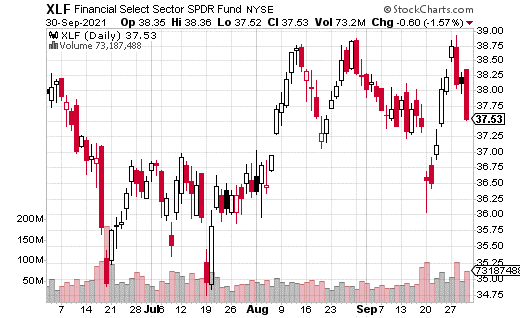It’s never a bad idea to know how to minimize your equity exposure, especially right now, as the market is showing some cracks in its armor lately, says Jay Soloff of Investors Alley.
The S&P 500 was down roughly 5% in September, the first down month in 2021 since January, and the largest since the pandemic hit in March 2020.
Granted, September tends to be a more volatile month than most—plus, quarter-end positioning can skew the numbers as well. Nevertheless, the third quarter ended on a down note. It can be a vital reminder that the markets don’t always behave.
Fortunately, there’s a straightforward solution to protecting your downside exposure: hedging with options.
The simplest way to hedge equity risk is to buy a put on an index, such as one that tracks the S&P 500 (SPX). The problem with this strategy is it can get expensive in a hurry. Index puts tend to be in demand as hedges, so their prices can be inflated.
Using vertical spreads (i.e., put spreads) can help alleviate these costs. You can spend a lot less in premiums by selling a further-away put, against the put you purchased for protection. The drawback is the put spread will cap your gains—especially in a crash-like scenario—however, it’s usually a reasonable tradeoff. Crashes happen rarely, but hedges are often made monthly. The costs can add up in a hurry, so it makes sense to lower the cost and accept less return.
What’s more, instead of using broad-based indexes (which can have high stock prices and thus high option prices), hedges can be made at a more granular level. Using sector ETFs is one way to accomplish this.
For example, I came across a put spread placed in Financial Sector Select SPDR Fund (XLF). XLF is the most popular exchange-traded fund (ETF) for tracking the financial sector. It includes banks, insurance companies, and asset management companies.
A strategist may have decided that the sector is due for a pullback or simply wants to protect against that scenario. Moreover, the S&P 500 was down 5% in September, while XLF was only down a little over 2%. A hedge in XLF could make sense if someone expects XLF to “catch up” to the S&P 500.

The trade—a put spread, as I described above—expires in November and was purchased with XLF trading $37.64. Specifically, the November 37 puts were purchased while the 32 puts were sold.
The entire put spread cost $0.82 (5,500 of the spreads traded in one block), which is also the max loss on the trade if XLF doesn’t drop below $37 by expiration. If the 37 puts were purchased by themselves, the trade would cost $1.06 instead.
The position breaks even at $36.18 but can make money all the way down to $32. In that case, $4.18 in profits could be realized at expiration. That’s a 510% return on the hedge (or downside speculative bet). In other words, it’s a relatively efficient use of capital to protect downside exposure in the financial sector.
Learn more about Jay Soloff at Investors Alley.





















